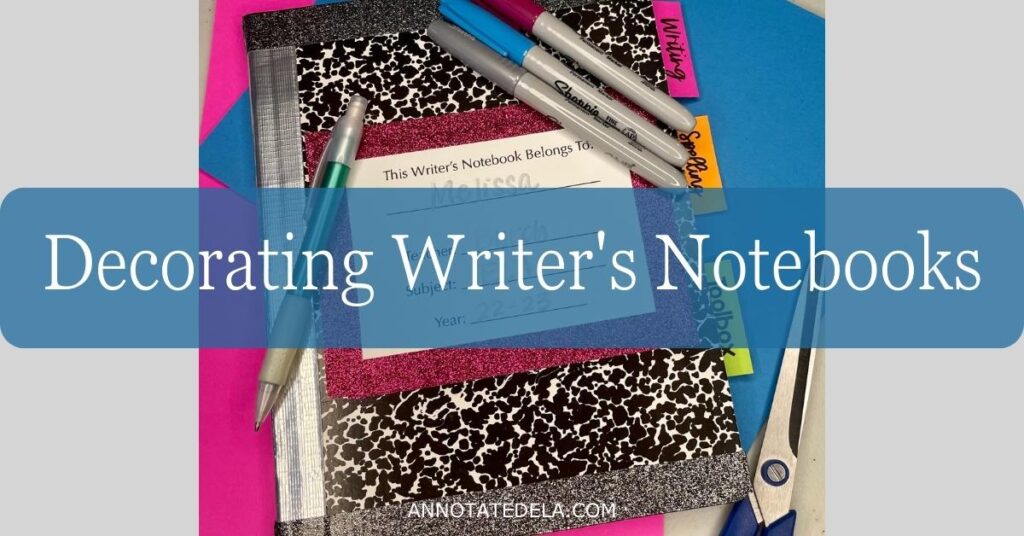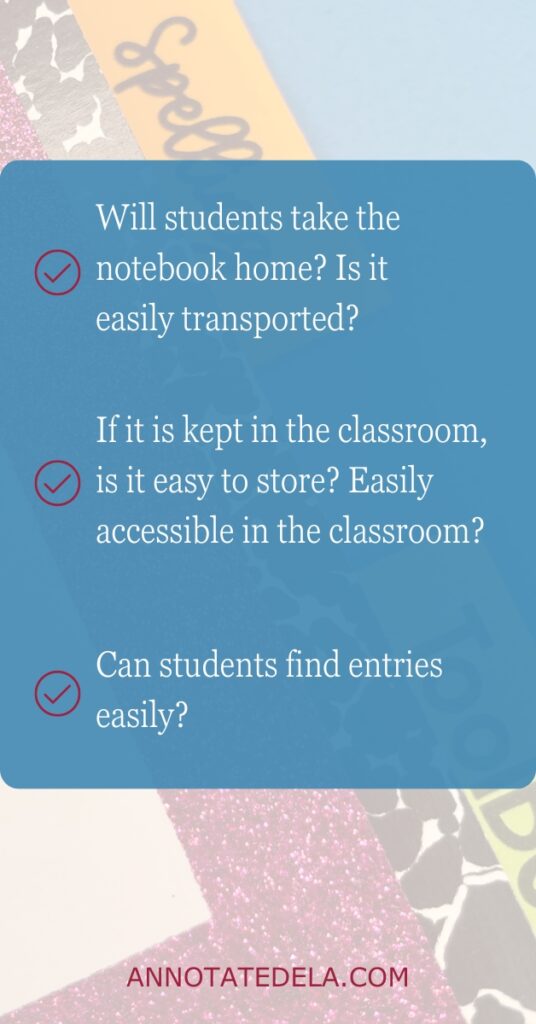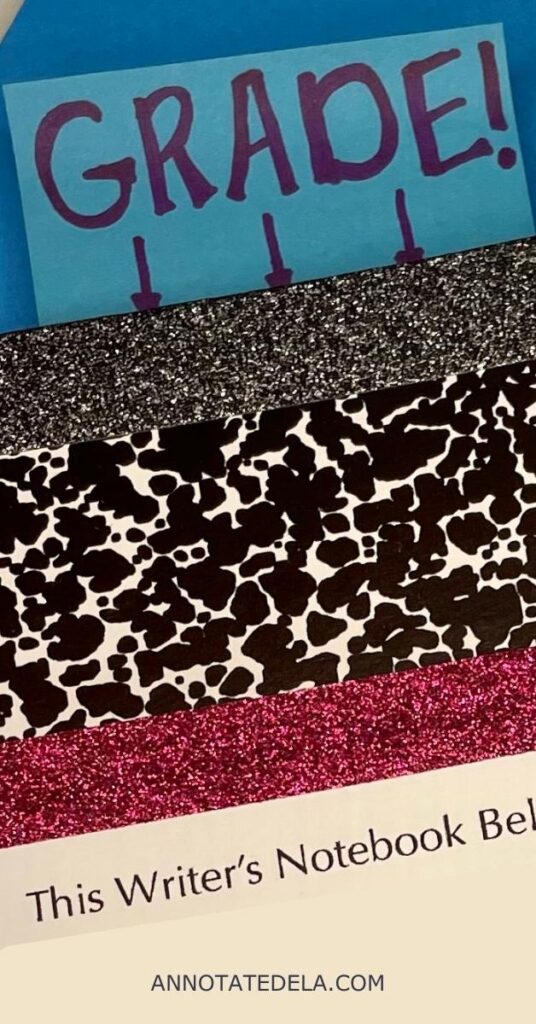Whether you are using writer’s notebooks with your students for the first time or the thirty-seventh time, the decisions for writer’s notebook are something even the most seasoned teacher should consider when planning.
Writer’s notebooks are a must for engaging students in writing. Thinking through the decisions has positively impacted how we use notebooks in the classroom. Involving students in the decisions promotes engagement and motivation because they have a sense of ownership and control over the notebook.
The seven key decisions for the writer’s notebook take into consideration how the expectations will be communicated to students and guardians. Having support will make a big difference in the success of the notebook and the writing.
Don’t worry, if you are already using notebooks in your classroom or notebooks have been purchased, GO WITH IT!! Use these questions to clarify what you are doing and guide decisions for future notebook use!
Want to use writer’s notebooks with intention and meet your student’s writing needs? With the 5-Day Writer’s Notebook Challenge, you can help your students become proficient writers and meet all levels of students where they are! Join me for five days as we transform how you and your students use notebooks!
Choosing a Writer’s Notebook

Notebook type is essential because it is the result of considering the other six decisions for writer’s notebooks. The writer’s notebooks should fit with the decisions you, the teacher, make but also be personal for the writer (student). This is why involving your students in the decision-making process is just as important.
Will it be a composition notebook, a spiral notebook, a binder, digital, or a smaller notebook? Student choice?
Wide or college ruled? Does it matter?
Consider accessibility – what is available for students to purchase and will extras be made available for students who are unable to get a notebook on their own?
If you prefer digital notebooks to be the notebook of choice, the other key decisions can still apply. Digital notebooks are versatile and can be easily managed and accessed from most locations.
Keep in mind the student population and accessibility for students when not in school if they are expected to write in their notebooks outside of school.
Can the Writer’s Notebook be Replaced?
It is likely that students will fill the notebooks and will need to replace it with a new one before the year is over. Accessibility to a similar notebook or any notebook is crucial for continuity.
Some writers find that they love the current notebook and will want to replace it with the exact notebook, while others may want to try something new – encourage students to stick with the current notebook style and structure. If it is working, don’t fix it. It might be helpful to have notebooks on hand for quick replacement.
To Decorate or Not to Decorate the Writer’s Notebook?

This might seem like a silly decisions for writer’s notebooks, but for some classrooms it may be very important to decorate or not.
Decorating the notebook makes it feel special, promotes creativity, and encourages a sense of ownership. The notebook is a sacred space for thoughts and ideas and decorating the outside provides a sense of the special contents inside. What supplies are needed? Will students bring materials from home?
The choice to not decorate makes sense too. For some students it can become a distraction from the contents of the notebook. It may even become a source of contention if the notebooks are kept in the classroom and a cover is ruined. Not decorating the notebooks is a valid decision and one that the teacher and students need to make.
All notebooks should have identifying characteristics and a place for students to put their names so notebooks can be easily identified.
How to Structure the Writer’s Notebook

In full transparency this has been a tough decisions for writer’s notebooks for me for many years. The structures used have served the students well and notebooks have been a success, but I tried to fit too much into one notebook.
I didn’t want to burden parents with having to buy two notebooks for my class, so I made all the tabs for all the sections and put them in one notebook – the vocabulary, the reading, the bell ringers, the writing, the writer’s craft…you name it, we had it in our notebooks. This was not a bad strategy. It worked. But it never felt right.
If this is how you structure notebooks, and it works, keep doing it! I applaud you! It worked for us too and I think it is a great way to structure notebooks.
Putting Less in the Notebook
I have since tried some new ways to structure notebooks and this has worked because it gave my students an internal locus of control over the notebook. We do all of our writing from the front of the notebook and any mini-lessons or craft lessons are from the back; it eventually all meets in the middle and it’s time for a new notebook.
Students are able to skip the first few pages IF they want to make a table of contents. They must make the commitment to keep the table of contents up-to-date as we add entries. However, students do not have to have a table of contents in their writer’s notebooks.
Some students use flags or sticky notes to mark entries. Working from the front and back of the notebook puts the student in charge of how to track entries and lessons. This truly engages the student in making decisions for writer’s notebooks.
It does not matter how you decide to structure the writer’s notebook. Consider a student’s abilities and organizational capabilities. Work through the decision with your students, they know themselves and you know your students.
There have been years when more guidance was needed to maintain the order of the writer’s notebooks. Decisions for writer’s notebooks should be based on student need.
Is the Writer’s Notebook Easily Managed by Students?
This is an extension of how the writer’s notebook is structured and also the type of notebook that is chosen. Knowing the expectations of the notebook will guide and help with this decision for writer’s notebooks. Knowing what is expected helps the student and teacher decide how to structure and manage the notebook.
When considering student’s ability to manage the writer’s notebook, also think about the following expectations:
Will students take the notebook home? Is it easily transported?
If it will be kept in the classroom, is it easy to store? Easily accessible in the classroom?
Can students find entries easily?

Remove or Add Pages in the Notebook?
Do students need to be able to add and/or remove pages from the notebook? If so, a binder or digital notebook may be the best option. However, composition books and spiral can lend themselves to adding pages, the pages would need to be stapled or glued, but again, that would be a consideration.
Reasons for adding or removing pages might be that a student is adding to a previously started entry and wants to connect them. Another reason may be that replacing a filled writer’s notebook is not an option, so being able to add pages is a necessity.
Removing pages may happen because a student started a rough draft in the notebook and needs to take it out or notes need to be moved and stored in a new way.
Whatever the reasons may be, it is crucial to think about what notebook will benefit the student’s use of the writer’s notebook.
Collect and Review the Writer’s Notebook

Is the writer’s notebook easily managed and collected by the teacher? It is important to review entries, not only to provide feedback, but writer’s notebooks are a place where students may share information that needs to be reported. So frequent and consistent checks are a necessary undertaking when implementing writer’s notebooks.
I would like to also add that this is made clear for the class, that writers notebooks are a safe space to explore hard topics, happy topics, and all topics in between, but it is also not private and if anything is shared that suggests harm to self or others it will be reported because teachers are mandatory reporters.
What, how, and when will you collect and review the notebooks? These are the key questions for making decisions for writer’s notebooks when collecting and reviewing.
Suggestions for Collecting and Reviewing
Have a procedure for what will be reviewed. Students use a sticky note with an arrow or the statement, “CHECK ME”. This points the teacher to the entry they want to be graded.
A simple rubric is used to review the entry and to check the other entries because consistently writing is on the rubric. This saves time and students know what is expected and how they will be graded.
Notebooks are checked once a week, sometimes every other week, if time is an issue. The teacher is conferring with students throughout the week so that some notebooks may be checked during that time. This saves time and allows the teacher not to have to collect them.

Writer’s notebooks benefit student writing and are a writer’s toolkit for mini-lessons and strategies. Notebooks are a key piece in writer’s workshops and writing conferences.
Decisions for writer’s notebook may seem trivial, but it is important to have a plan for the notebooks or the notebooks will have a plan for you!
It is even more important to determine what is BEST for your students – would a digital notebook serve your students (or some of your students)? Guide the final decision with student needs.
The magic is in the process!





4 Responses